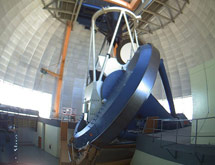
Handy Links
SLAC News Center
SLAC Today
- Subscribe
- Archives: Feb 2006-May 20, 2011
- Archives: May 23, 2011 and later
- Submit Feedback or Story Ideas
- About SLAC Today
SLAC News
Lab News
- Interactions
- Lightsources.org
- ILC NewsLine
- Int'l Science Grid This Week
- Fermilab Today
- Berkeley Lab News
- @brookhaven TODAY
- DOE Pulse
- CERN Courier
- DESY inForm
- US / LHC
SLAC Links
- Emergency
- Safety
- Policy Repository
- Site Entry Form

- Site Maps
- M & O Review
- Computing Status & Calendar
- SLAC Colloquium
- SLACspeak
- SLACspace
- SLAC Logo
- Café Menu
- Flea Market
- Web E-mail
- Marguerite Shuttle
- Discount Commuter Passes
-
Award Reporting Form
- SPIRES
- SciDoc
- Activity Groups
- Library
Stanford
Around the Bay
Dark Energy Survey Collaboration Meets at SLAC
Ninety-five percent of the universe is made of something mysterious and "dark," according to the standard cosmological model. And while a portion of that darkness—dark matter—may soon be better understood through experiments in deep underground mines and at CERN's Large Hadron Collider, most of it—dark energy—remains almost entirely inexplicable.
An international collaboration of researchers seeks to change that through the Dark Energy Survey. More than 100 DES collaborators are meeting at SLAC this week to discuss how they will map dark energy, the mysterious force that seems to accelerate the universe's expansion, to reveal why the universe is expanding at an ever-increasing rate.
"Dark energy is one of the biggest puzzles in physics and the Dark Energy Survey will explore new territory with four independent measurements," said Kavli Institute of Particle Astrophysics and Cosmology researcher Risa Wechsler, who chairs the science program for this week's collaboration meeting.
The physicists will observe dark energy by determining the distances to supernovae, the bending of light around large objects with strong gravitational pull, and both the structure and timing of galaxy clustering. Each of these measurements will reveal how fast the universe has been expanding and how quickly galaxies and clusters form over time. Because the four approaches are independent of one another, they will also allow the scientists to cross-check their results, offering the most comprehensive view of dark energy to date and, the researchers hope, determining whether or not the density of dark energy in the universe remains constant as the universe expands.
To do all of this, the DES collaboration is building the largest digital camera in the world. At more than a half meter in diameter, the camera will record the sky in optical light once it is installed onto the 4 meter Blanco Telescope at the Cerro Tololo Inter-American Observatory in Chile. Using the camera's 520 megapixels, large size and ultra-sensitive silicon detectors, the DES collaboration will search the sky for evidence of dark energy.
"We expect to see about 300 million galaxies—looking as far back in time as when the universe was a third its present age, to view 100,000 new galaxy clusters, to capture 3,000 supernovae and to get weak lensing measurements over half the age of the universe," Wechsler said. "In addition, the survey will make contributions to our understanding of galaxy evolution, the nearby universe and quasars."
Wechsler leads the Galaxy Evolution group, one of 11 DES working groups. She and several other SLAC researchers also work on analysis of gravitational lensing, galaxy clusters, large scale structure and simulations as part of a consortium made up of SLAC, Stanford University and the University of California, Santa Cruz. In addition to their data analysis efforts, SLAC researchers also collaborate with Fermilab and the University of Illinois on the camera's hardware and software, and on analyzing the performance of the camera and telescope.
"Work on the camera and telescope is progressing well," said SLAC Professor David Burke, who chairs the local organizing committee for this week's meeting. "At this meeting, the collaboration is reviewing that work and discussing what additional work needs to be done in order to prepare for first light in 2011."
Learn more about the Dark Energy Survey in the July issue of Symmetry magazine.
—Kelen Tuttle
SLAC Today, December 1, 2009
